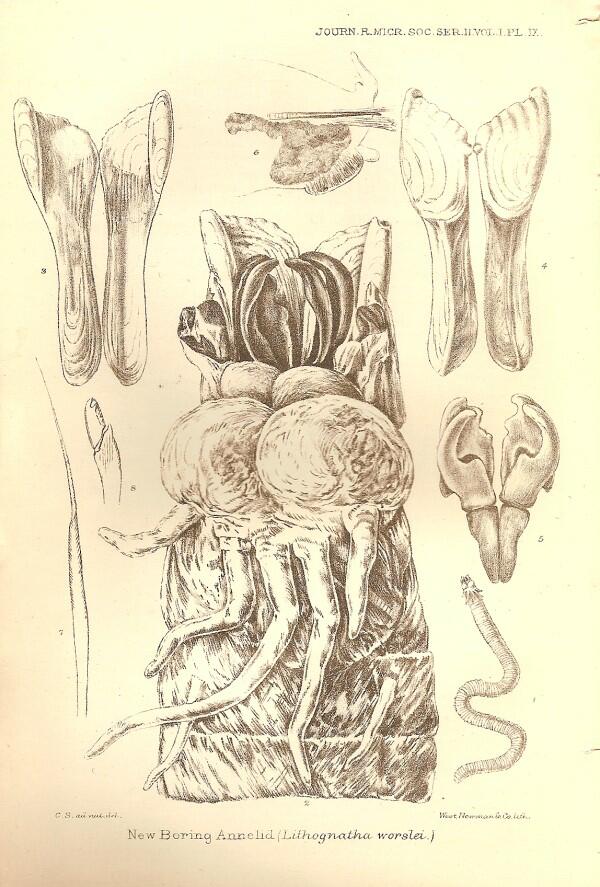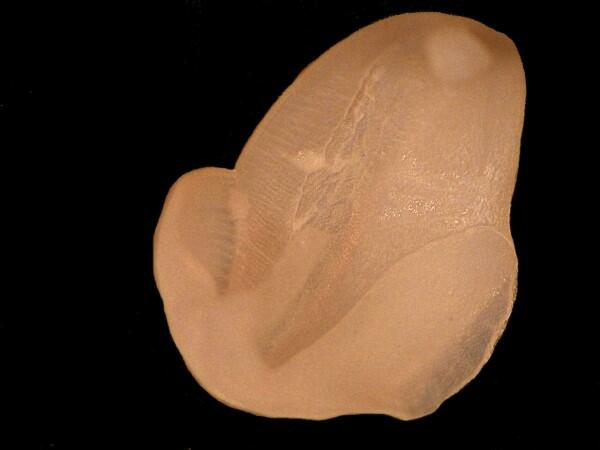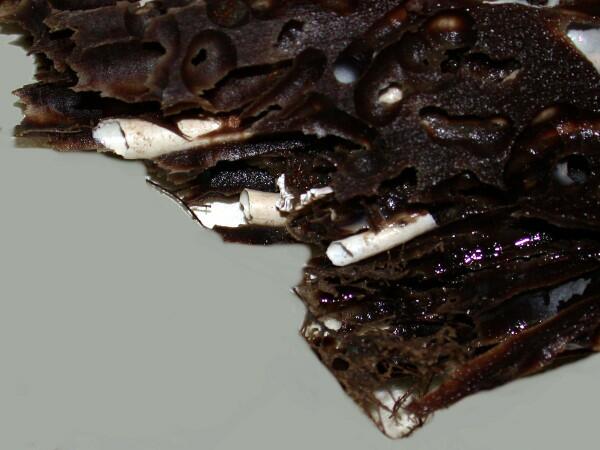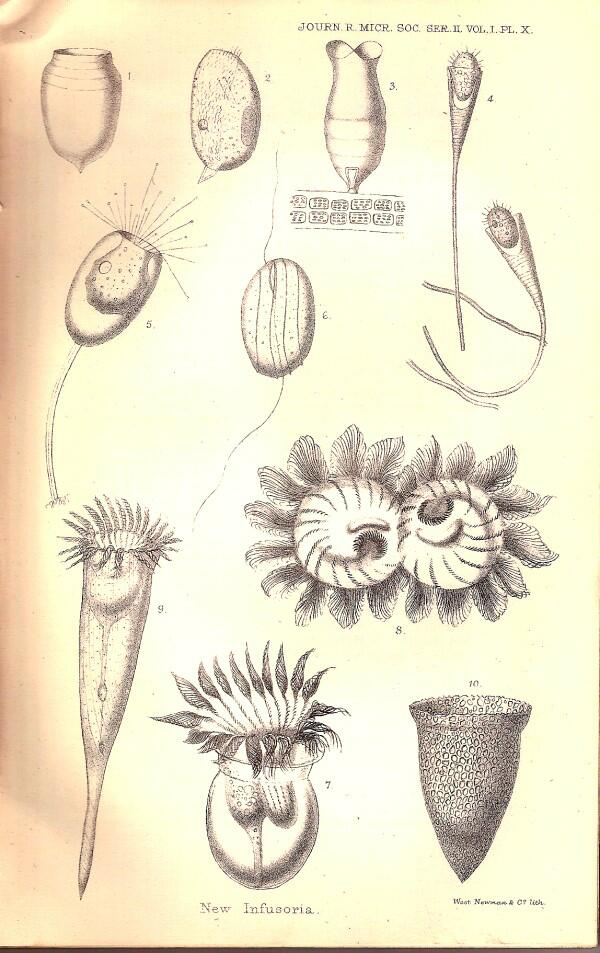
|
Nineteenth Century British Microscopy and Natural History: Part 3 by Richard L. Howey, Wyoming, USA |
Once again, I wish to take a look at another issue of the Journal of the Royal Microscopical Society, this time, the October 1881 issue. The main introductory article is quite brief, but also quite intriguing. It is by Charles Stewart and is titled “On a supposed new Boring Annelid.” (Mr. Stewart may think it’s boring, but I find it quite interesting.–Ah, the vicissitudes of the English language.) Actually, there are a number of types of boring marine organisms from sponges to worms to mollusks. The so-called shipworm which bores into the timbers of ships is actually a mollusk. This article is accompanied by a plate showing drawings of the worm and its relevant component parts which I’ll scan and show you here.

In the lower right hand corner, you have a depiction of the whole worm which looks like it belongs to the group of nereid worms. We’ll discuss some of the other details of the plate in a bit.
Here is Mr. Stewart’s opening sentence.
“I am indebted to the Directors of the Eastern Telegraph Extension Company for the opportunity of examining some animals obtained at the time their cable, laid off Singapore, was raised to repair some faults.”
Here, in 1881, is an undersea telegraph cable with sections encrusted by organisms and possibly a new species of worm that is creating problems for humans by boring into the cables. Human beings now have tens of thousands of miles of undersea cable. I wonder what they’re made of. Do their casings contain worm repellent? Are there anti-encrusting chemicals in the cable surfaces? Just think of all the sunken warships that are in the sea, now providing habitats for countless numbers of organisms. Wouldn’t it be nice if all the money that countries all over the world put into war and destruction were channeled to feeding, educating, and healing people so that they could go out and do fascinating research? Ah, but there I go daydreaming again.
Now, of course, we depend more and more on communication satellites and less on underwater cable. So, wouldn’t it be a wonderfully exciting project to pull up some of the old cable with all of its encrusting organisms, cut it into sections and provide pieces to various oceanographic research institutions to study and also each Micscape contributor would get his or her choice of a preserved or live section to investigate. If you had a nice, large marine aquarium, you could opt for the live section; if, like me, you don’t have such facilities, then you’d choose a preserved piece. More daydreams.
Interestingly, the encrusted areas of the cable were apparently limited to points at which the outer layer of the cable had been breached by some organisms. Mr. Stewart observes:
“The cable when laid consisted of a central core of copper wire surrounded by guttapercha, outside this was a layer of oakum and tar, followed by iron wire, and this finally invested by another layer of oakum and tar. As long as this outermost covering remained the cable was almost free from incrusting organisms, but as soon as the iron wire was exposed by the disintegration of the oakum, it became densely covered by numerous animals such as Serpulae, corals sponges, &c. It was in these incrusted portions of the cable that the faults were always found, and were believed by the captain, Mr. Worsley, to be due to the attacks of some boring worm, with which opinion I entirely concur.”
Clearly an occasion for another National Inquirer headline:
BORING UNDERSEA ALIEN WORMS
ATTACK TELEGRAPHIC CABLES:
ARE THEY SENDING US A MESSAGE?
What the devil is oakum? Gutta-percha? Unlike you, I had to look them up, because I had only the vaguest notion of their identity. Oakum is made by picking fibers from old ropes and mixing it with pine tar and was used extensively on old ships. It was very tedious work and was mostly done by prisoners and slaves. Gutta-percha is a rubbery compound from the latex of several kinds of tropical trees and was used to waterproof. In the 19th and early 20th Centuries, all sorts of materials were used that are now unfamiliar to many of us. Microscopists used to employ gold size in slide mounting. I think my gold size is about 250 pounds. Probably few of you remember that in 1945, the Aga Khan had himself weighed in diamonds (243 pounds) to celebrate his diamond jubilee. I can imagine that every day there were long lines of adoring citizens standing in line to bring him doughnuts, French fries, cream puffs, Kirschkäse, chocolate cheesecake, etc. He had already been weighed in gold on his golden jubilee and was scheduled to be weighed in platinum in 1954. Actually gold size is a solution which is a mixture of red and white lead along with yellow ocher in linseed oil. In other words, a poisonous liquid used as a sealant for microscope slides. Microscopists used lamp black, Venice turpentine, and all sorts of other substances which are difficult or virtually impossible to obtain today, such as, cocaine hydrochloride and strychnine sulfate which were used as anaesthetics for aquatic invertebrates. But now I know what oakum and gutta-percha are. Stewart deduces that the fact that this worm is able to bore through a variety of materials shows that it uses mechanical rather than chemical means. He places the worm in the group Eunicidae which certainly seems reasonable based on its general appearance and morphology. However, what is unique to this worm is that it has 3 pairs of chitinous jaws, but also a pair of calcareous jaws (these can be seen in the drawings) and this latter is not a feature of the Eunicidae. So what’s the big deal about a pair of calcareous jaws? After all, chalk is calcium carbonate and it’s soft and crumbly. Another one of nature’s amazing bits of ingenuity. Calcareous structures show up all over the animal world, in some kinds of plants, and even in slime molds. Nature combines calcium carbonate with a variety of other compounds and shapes, molds, sculpts it in a remarkable number of ways to produce everything from soft chalky structures to barnacle plates to the shells of Tridacna, the giant clams which can weigh more than 400 pounds, to the radically modified shells of the shipworm Teredo. This latter instance is of special interest here. Teredo looks like a rather uninteresting (boring) brown, thin worm with some odd white calcareous plates at the anterior end which it uses for boring, boring into the timbers of ships, wharf piling, anything that’s handy and they are not only a nuisance, but a real danger in that over time they can threaten the integrity of the timbers. The fascinating thing is that is that this small, odd creature is really a mollusk and these modified plates are all that is left of its shell.


Even more amazing these plates are rotated by the mollusk to drill through the wood and as it moves through its tunnel, it secretes a thin calcareous deposit that lines the tunnel. It is well known that termites cannot digest cellulose and are dependent upon symbiotic protozoa and bacteria which live in their intestines to break it down into starches and sugars which they can metabolize. (See my Micscape March 2003 article You Want to Bring THOSE Into the House and the Termite Symbionts page on my website). How does Teredo break down cellulose? From what I can discover, it is apparently a combination of bacteria in the intestine and the action of the enzyme cellulase which Teredo can secrete.
An even more interesting issue is how does Stewart’s worm digest oakum and gutta percha? So many question, a large number of which we don’t know the answers to. We need armies of biologists, not soldiers.
Speaking of protozoa, there are several interesting discussions of these organisms and two of these discussions are linked to a plate with marvelous drawings. The discussions are a quite brief one titled “New Infusoria” and a longer one titled “The Tintinnodea.” Here is the plate.

Drawings 1 through 6 are discussed in the first note regarding an article by C. Mereschkowsky (a good Irish name), #4 being from the White Sea, #2,3,5 being from the Black Sea and # 1,6 being from the Bay of Naples which had the first marine research laboratory established in 1875. Clearly #5, identified as Acineta livadiana is a suctorian which is a ciliate in which, in the adult state, the cilia are lost and the organisms develops tentacles with minute, sticky disks at their ends. I have found 3 or 4 species of suctorians in this area, but whenever I think of suctorians, I think of Lake Baikal–one of the most extraordinary environments in the world. For starters, Baikal is enormous; it contains 1/5th of the surface freshwater in the world! At one time, it had a channel to the sea and all kinds of organisms migrated into it, then it closed off again and created a unique habitat for many organisms found nowhere else in the world–a remarkable variety of freshwater sponges, unusual algae, freshwater seals, and, of course, suctorians. There are many species of suctorians (and diatoms and algae, gammarids, and mollusks) that have been found nowhere else in the world. So, here’s a place where we need to deploy several brigades of biologists–training in Russian strongly preferred. The Russians have taken some measures to protect Baikal but, in the end, they are woefully inadequate. There are large lumber mills right alongside the lake and enormous quantities of wood pulp have been dumped into the water.
The account of the second article deals with drawings #7-10. The tintinnids are a fascinating and rather obscure group of protozoans which construct a “house” (or test or lorica) with a substantial large opening at the anterior end. These houses are usually shaped either like a round-bottomed flask (#7) or an elongated vase, pointed at the posterior end (#9,10), are gelatinous in nature, and are often covered with sand grains. As is evident from the drawings, the ciliary structures are feathery. While most tintinnids are marine, there are a number of freshwater species and I have found them in a sizeable lake about 25 miles southwest of Laramie. They are present in the very early spring when the water is still very cold and some ice yet remains on the lake.
Nineteenth and early Twentieth Century microscopists seem to have had a greater passion for seeking out new organisms and surveying areas to see what variety occurred within a particular locale. Today, there is much more emphasis on examining a relatively few organisms with an incredible battery of high-tech instruments and elaborate molecular biological techniques. Such investigations are far beyond the reach of amateurs, who nonetheless, can play an important role in collecting, describing, photographing and publishing accounts of unusual organisms on sites like Micscape where eventually some of this material will be noticed by professional researchers. After I published the article on Trichoplax, I stated getting e-mails and even phone calls from scientists who were anxious to acquire specimens in order to do DNA sequencing. Unfortunately, these inquiries came months or even a year or two after the article appeared and I no longer had any of the organisms in culture. To this day, I still get requests for samples of Lacrymaria and that article is one of the earliest which I sent to Micscape. When I have them in culture, I’m glad to send samples but, in case you want some, I don’t have any right now.
There are some professional databases of protists online, but sometimes the image quality is rather poor and many of the images on Micscape are superior both in format-size and resolution. With its many links to other sites, its article, its news items, and its archive, Micscape plays a role not all that dissimilar from the fine scientific journals of the 19th Century. Such a valuable resource deserves our support both in terms of donations and contributions of articles.
All comments to the author Richard Howey are welcomed.
Editor's note: Visit Richard Howey's new website at http://rhowey.googlepages.com/home where he plans to share aspects of his wide interests.
Microscopy UK Front
Page
Micscape
Magazine
Article
Library
Please report any Web problems or offer general comments to the Micscape Editor .
Micscape is the on-line monthly magazine of the Microscopy UK website at Microscopy-UK .